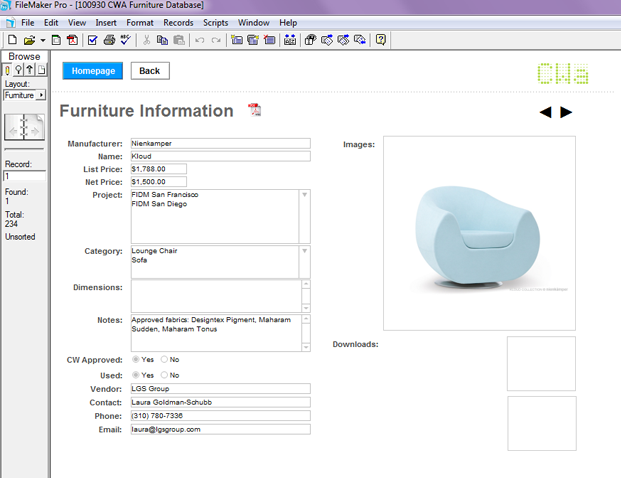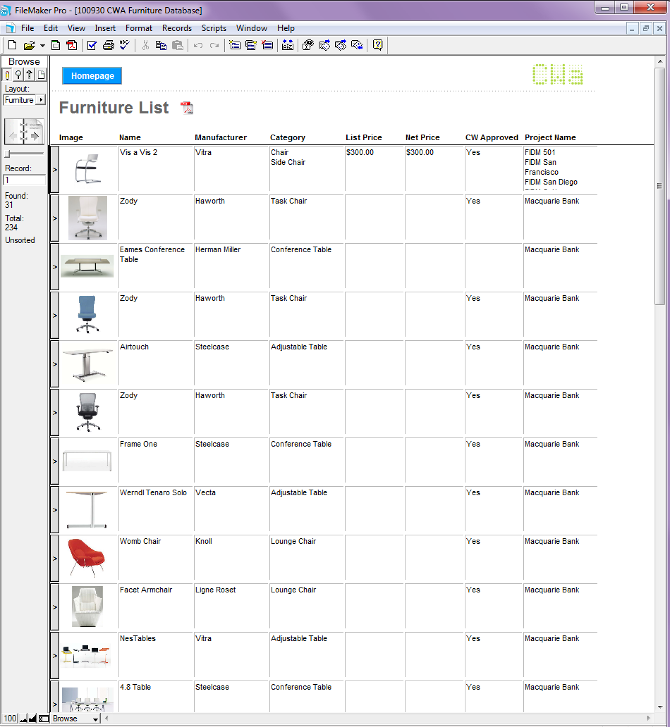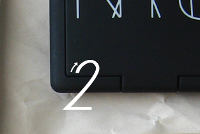Furniture Database
A large part of my job as an interior designer was furniture and finish specification. This database was borne out of my frustration with the senselessness of repeated researching.
PROBLEM
Although we used a lot of the same pieces over and over again, we always researched the same details (price, lead time, dimensions) as if it were the first time.
Once, while I was in the middle of chair and sofa options, a co-worker passed by, looked over, and commented that the fabric they used on one of the sofas in a past project upholstered really badly and had to be taken back to the manufacturer. It turned out that because of the organic shape of the sofa, only certain types of fabrics could be used. I was thankful for the heads up, but I thought to myself, what if he had never walked by and told me this? Wouldn't it have been completely senseless to make the same mistake twice? Imagine all the wasted time and effort. And all because we had no means of keeping track of important information like this. What other vital pieces of information are now lost with former employees?
SOLUTION
The furniture database enabled us to share spec information across people and time, and addressed questions such as:
01. "There's a chair we used at so-and-so project that the client loved, what's that chair again?"
02. "What sofas have we used and has the boss liked in the past? Let's avoid starting from scratch and use that list as a jumping off point for this new project."
03. "We need a chair under $200. What are our options?"
04. "Have we encountered problems in the past with this piece? What do we need to tell the manufacturer to pay close attention to?"
05. "We need to put a budget together tonight! We like this sofa, how much is it?" Usually, you would have to wait until the next day to call a sales rep to get an answer as prices are not listed on websites, and it's common for manufacturers not to release price books to clients.



PROBLEM
Although we used a lot of the same pieces over and over again, we always researched the same details (price, lead time, dimensions) as if it were the first time.
Once, while I was in the middle of chair and sofa options, a co-worker passed by, looked over, and commented that the fabric they used on one of the sofas in a past project upholstered really badly and had to be taken back to the manufacturer. It turned out that because of the organic shape of the sofa, only certain types of fabrics could be used. I was thankful for the heads up, but I thought to myself, what if he had never walked by and told me this? Wouldn't it have been completely senseless to make the same mistake twice? Imagine all the wasted time and effort. And all because we had no means of keeping track of important information like this. What other vital pieces of information are now lost with former employees?
SOLUTION
The furniture database enabled us to share spec information across people and time, and addressed questions such as:
01. "There's a chair we used at so-and-so project that the client loved, what's that chair again?"
02. "What sofas have we used and has the boss liked in the past? Let's avoid starting from scratch and use that list as a jumping off point for this new project."
03. "We need a chair under $200. What are our options?"
04. "Have we encountered problems in the past with this piece? What do we need to tell the manufacturer to pay close attention to?"
05. "We need to put a budget together tonight! We like this sofa, how much is it?" Usually, you would have to wait until the next day to call a sales rep to get an answer as prices are not listed on websites, and it's common for manufacturers not to release price books to clients.













